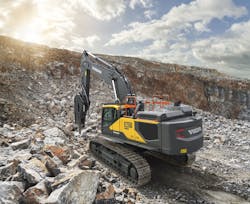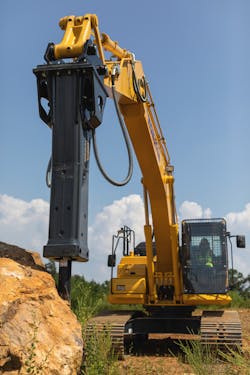Hydraulic breakers are becoming smarter and heading to a breakout future. The Infrastructure Investment and Jobs Act (IIJA) should bring plenty of work for hammers as they chip through structurally deficient old bridges, bust away outdated pavement, and clear out the old for new construction. Maximizing breaker productivity for these projects starts with proper pairing of the hammer, carrier, and application.
Matching the right hydraulic breaker to a job is a balancing act of considerations. The core machine considerations for matching a breaker to its carrier are the machine’s operating weight, its hydraulic flow characteristics—operating pressure, hydraulic flow rate, auxiliary flow rate—its overall lift capacity, and the geometry of the carrier’s boom design, all of which contribute to operating stability.
How to match a breaker to its carrier
Breaker manufacturers and OEM compatibility charts provide a range of mechanical and operating requirements proven to pair specific sized carriers efficiently with various breakers. These listings are a good starting point and provide a proven foundation on which to add other considerations such as the job’s material type, time constraints, and the contractor’s budget.
“Correctly matching the breaker to the available carrier is crucial to optimize efficiency as well as protect the contractor’s equipment,” says Joe Tedesco, president of Gorilla Hammers/Tech Hydraulics. Tedesco says selecting the right hammer for a job begins with the carrier’s size and its oil output.
“The key to fitting the right hammer to the machine is a test with a flow meter to make sure the hydraulic flow pressure matches the capabilities of the hammers,” says Tedesco.
“To maximize the life and efficiency of a hydraulic hammer while putting as little strain on the hydraulic system as possible, the carrier must be set up to deliver oil to the hydraulic breaker at the correct volume, pressure, and relief without exceeding the backpressure limitations of the hammer.
“Too much oil or pressure will cause the hammer to overspeed, which reduces seal life and can damage internal components,” he says. “Improperly set relief or excessive backpressure can cause the breaker to overheat and transfer heat to the carrier’s hydraulic system. Too little oil flow reduces the breaker’s impact power. Additionally, too little oil flow won’t provide the necessary lubricating film between internal moving parts and lead to damage.”
According to Joel Escalante, senior product specialist, Doosan Infracore North America, “The proper rule of thumb for excavator/breaker matching is to ensure one pump flow. For instance, if the maximum flow on an excavator is 2 x 50 gpm = total of 100 gpm, the maximum flow requirement by the breaker should not exceed 50 gpm. In other words, if the flow required is 60 gpm, you must use a bigger excavator or reduce the size of the breaker.”
“Most carriers have adjustable hydraulic systems to perform this fine-tuning,” Tedesco says, “but a qualified hydraulic technician with the proper flow meter to measure all of the hydraulic values simultaneously throughout the operating range is the only way to optimize your hydraulic breaker’s performance and protect your carrier.”
How weight affects breaker performance
Stability is critical for safe and efficient breaker performance. The balance between the carrier’s and hammer’s weights, along with the lift capacity and length of the arm, need to match to avoid a damage to the breaker or the carrier.
“If the carrier is equipped with a quick-hitch mounting bracket, consult the operating manual of the quick-hitch bracket before you attempt to mount the product,” says Todd Cannegieter, product manager for Volvo Construction Equipment. “Faulty bracket geometry may lead to contact and cause expensive damage to the boom cylinders.”
Not only does the machine need to be able to move and position the breaker, but it is also important that it can handle the forces from the breaker.
“Your carrier has to be heavy enough to safely carry the hammer at all angles and extensions of the boom and stick without tipping the carrier or causing too much diving when the hydraulic hammer breaks through the material being demolished,” Tedesco says. “The carrier also must be large enough to withstand the recoil that all hydraulic hammers transfer back to the carrier while operating. Too much recoil can loosen the hammer’s supply pipes and clamps and can affect the carrier’s weldments.”
More than productivity is directly affected by the breaker’s size—and as tempting as it might be to select the biggest, baddest breaker available—assuming the “big job, bigger tool” mindset can lead to less efficiency and possible damage to the carrier.
A hammer that is too heavy for the carrier’s lift and stability limits severely weakens the operator’s ability to lift the hammer efficiently and move across the material being broken. This is especially important when breaking hard, rounded, and unevenly shaped rock where the operator must move frequently to find fissures, weak spots, and striking points. An oversized breaker transmits energy in two directions: both toward the material and resonating through the carrier. This produces wasted energy and can also damage the carrier. An excessively heavy bracket may increase the weight of the attachment more than the lifting capacity of the carrier allows, says Cannegieter.
On the other hand, a hydraulic breaker should not be too small for the carrier. Each carrier exerts down-pressure on the hydraulic hammer as it is planted on the material to be broken. If the hammer is too small, excessive down-pressure will cause the frame to twist, damage mounting adapters and produce weldment cracks, according to Tech Hydraulics.
How to pick the right breaker
Matching the tool to the application also depends on the type of rock and how the rock breaks. Additionally, material hardness (its Geological Strength Index), material size, production requirements, and duration of the project determine the pairing. If the work involves large and hard material, high production requirements, and a project that will last for several months, experts recommend using the largest attachments appropriate for the available carrier size.
“Every contractor has a breaker in his fleet,” Aaron Scarfia, Komatsu’s manager of North America attachment division, says. The type of hammer the fleet manager keeps on hand depends on the kind of work his firm does regularly: concrete demolition, boulder busting, trenching, etc.
“For constant full impact, when you just need to hit hard with every stroke the same force and frequency to break up hard rock, gas fired breakers such as Komatsu’s G-series are very productive,” Scarfia says. “Seventy-five percent of gas-fired hydraulic breaker energy is produced by nitrogen and the remaining energy is hydraulic. The nitrogen is contained in a pressurized vessel and produces identical force for each strike.” Komatsu says that because gas breakers have fewer moving parts, they deliver maximum reliability.
The addition of Komatsu’s “smart” 100-precent hydraulic V-series multiple speed variable breakers are adding even finer breaker control.
“Even before the operator can feel the rock break, the multiple speed breakers can detect and automatically shift to select the best piston stroke length and speed,” Scarfia says. “Because the V-series breakers are not dependent on the operator’s observations and reactions, the opportunities for blank firing are significantly lessened. That decreased blank firing, along with full upper and lower suspensions to dampen the impact of the breaker, protects the excavator boom and arm, and adds years to the breaker’s service life.”
Escalante says the operator must follow the proper recommendations in the breaker and machine’s manuals.
“Breaker point types vary upon application and provided the right point is used, we strongly recommend avoiding activating the breaker for long stretches of time,” he says. “If the material does not break within 15 to 20 seconds, reposition the tool and try again. If the breaker is activated for a full minute, the high idle period should be one minute before resuming operation.”
Foot-pound ratings and classes are reported in ranges, not hard numbers, so matching brand breakers to its brand family carrier presumes the pairing is optimal. In the case of Komatsu, Scarfia says the company tested its full line of breakers with the company’s complete machine line up for years before releasing the new breaker line. The same can be said about coupler compatibility.
According to Cannegieter, making sure the mounting adaptor design tightly corresponds with the attachment ensures safe operation and helps avoid structural issues. Although an OEM can be a one-stop-shop for the complete package (machine plus breaker), Cannegieter says a third-party vendor may be able to support its breaker better or react quicker than an OEM.
Whether the equipment maker or attachment maker provide the breaker, the correct balance between carrier and tool ensures maximum strike efficiency for the project.


